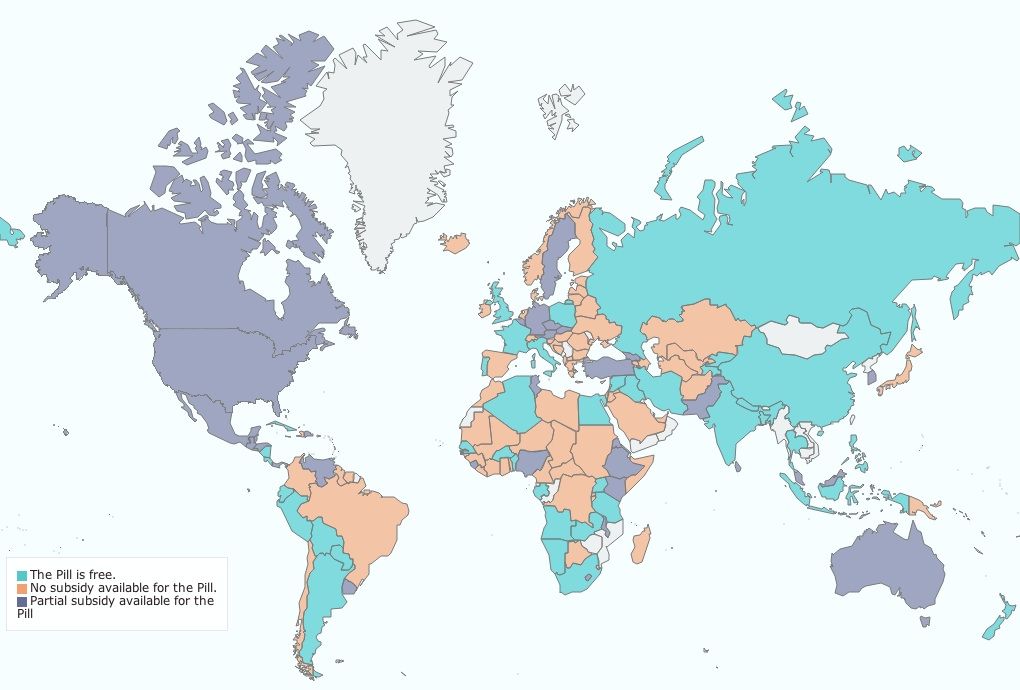General Discussion
Related: Editorials & Other Articles, Issue Forums, Alliance Forums, Region ForumsCountries where 'the pill is free':
<snip>
Using data from Harvard University's Center for Population and Development Studies, Slate put together a map of where almost every country in the world stood on public provision of oral contraceptives. They divided the world into three categories: "the pill is free" (blue), "partial subsidy" (purple), and "no subsidy" (orange). Here's how the globe looks, adjusted for today's ruling:

One thing that's interesting here is the total lack of consistency. North America is the only continent where the pill is free or subsidized everywhere. In Western Europe, most countries offer a full or partial subsidy for the pill, but Spain and Ireland - two countries with strong Catholic roots - offer none. Neither does much of former-Soviet Eastern Europe. In the Middle East, maybe unsurprisingly, Saudi Arabia does not offer subsidies for the pill - but Iran makes it free. Norway doesn't subsidize the pill, but Sweden does. This suggests there's no clear consensus, regionally, about the state's proper role in providing birth control.
Inside countries, there are some interesting patterns. J.M. Ian Salas, an economist at the Harvard center Slate's data came from, wrote up the results of several recent papers on birth control subsidies around the world. Here's what he found:
1-Despite a financial crisis and a sharp increase in contraceptive prices between 1998 and 2008, Indonesian birth control use rates remained stable. The government-run National Family Planning Institute, set up in 1968, distributes contraceptives and provides family-planning counseling.
2-Comparative studies of six African countries found that the abortion rate increased when access to contraceptives, provided by non-governmental organizations, decreased in the countries that most depended on NGOs to subsidize contraception.
3-Poor Filipino women were significantly more likely to have an unplanned birth after even a temporary disruption in free access to contraceptives.
<snip>
More:
http://bit.ly/1oiXfWk
SCOTUS-MEH!
littlemissmartypants
(22,656 posts)Eureka
(523 posts)In Aus, it seems to me (male, having never used it) this it's $11.50 for four months
http://www.chemistwarehouse.com.au/product.asp?id=5951&pname=Levlen+ED+Tablets+4+x+28
The link says prescription required, but they can be had for free.
Also, very few crazy people harassing your for your choice.
I think the graph needs more gradient colors to help us understand, but I totally agree with your premise.
WillyT
(72,631 posts)JayhawkSD
(3,163 posts)The cost of it is included in the cost of your health insurance. If the policy does not include it, then the premium you pay will be lower. You will then buy it with cash and the cost will be less, because the cost will not include the insurance company's overhead.
This mania for having the cost of "wellness services" included in the premiums, known as "free doctor visits" and "free medications" is actually causing the cost of health insurance to go up. The providers charge for those medications and services and the insurance companies pay those charges. They add overhead, which the ACA allows to be a 25% markup, and add that cost to the premiums it charges. That means that you pay 25% more for those services when you receive them "free" than you would pay if your insurance did not include them.
The ACA only allows 20% you say? No. The ACA requires that 80% of premiums payments be paid out for medical services. In order to achieve that 20% margin, the costs muct be marked up by 25%. A $20 service is marked up by 25%, for instance, or $5, adding $25 to the premium. 80% of $25 is $20, so the requirement is met.